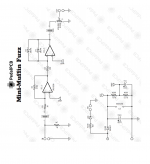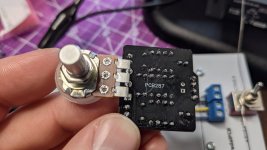bakewelder
Member
Preface: Noob here.
Troubleshooting the Mini-Muffin Fuzz. Passing signal, though only slightly distorted, not fuzz.
After C1, signal drops significantly. Virtually no prob-able audio at inputs of IC (pin 2 or 3). Output of IC at Pin1 is plenty loud, not distorted. Signal at C2 (post diodes and output of IC B) is distorted but more like slight overdrive, not fuzz.
Tried a new IC, same results.
Any suggestions? thanks!

Troubleshooting the Mini-Muffin Fuzz. Passing signal, though only slightly distorted, not fuzz.
After C1, signal drops significantly. Virtually no prob-able audio at inputs of IC (pin 2 or 3). Output of IC at Pin1 is plenty loud, not distorted. Signal at C2 (post diodes and output of IC B) is distorted but more like slight overdrive, not fuzz.
Tried a new IC, same results.
Any suggestions? thanks!




